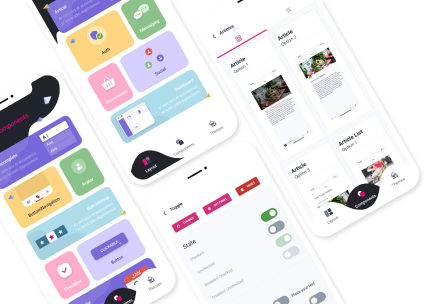What Is a Component in React Native?
4 min readReact Native is a popular framework for building cross-platform mobile applications. At the heart of React Native development lies the concept of components. Components are fundamental building blocks that encapsulate reusable pieces of user interface and logic, providing a structured and modular approach to app development. In this article, we will delve deep into understanding what components are in the context of React Native, their significance, and how they contribute to creating powerful mobile applications.

Understanding Components in React Native
React Native follows the same underlying principle as React, which is to break down the user interface into small, self-contained units called components. A component in React Native can be thought of as a JavaScript function or a class that returns JSX (JavaScript XML) to describe the structure and appearance of the user interface. These components can then be combined together to create complex UI hierarchies.
The Anatomy of a React Native Component
In order to grasp the concept of components fully, let's dissect the anatomy of a typical React Native component:
State
Components can have an internal state, which represents the dynamic data associated with them. State allows components to manage their own data and update the user interface based on changes in that data.
Props
Props (short for properties) are inputs that can be passed to a component from its parent component. They provide a way to customize the behavior and appearance of a component.
Lifecycle Methods
React Native components have lifecycle methods that allow developers to hook into specific moments during the component's lifecycle. These methods enable actions such as initializing the component, updating it when props or state change, and cleaning up resources when the component unmounts.
Styling
Styling in React Native is done using a combination of inline styles and predefined style objects. Components can have their own styles or inherit styles from parent components.
The Power of Reusability and Composition
One of the main advantages of using components in React Native is their reusability. By encapsulating specific functionality or UI elements into separate components, developers can build a library of reusable components that can be used across multiple screens or even different projects. This not only saves development time but also ensures consistency and maintainability.
Components can also be composed together to create more complex components, similar to how Lego blocks can be assembled to build intricate structures. This composability allows for a modular approach to app development, where smaller components with well-defined responsibilities are combined to form larger, more powerful entities.
FAQs about React Native Components
FAQ 1: What Are the Different Types of Components in React Native?
Answer: React Native offers two main types of components – functional components and class components. Functional components are simple JavaScript functions that take props as input and return JSX. Class components, on the other hand, are ES6 classes that extend the base React.Component class and provide additional features like state and lifecycle methods.
FAQ 2: How Can I Pass Data between Components in React Native?
Answer: In React Native, data can be passed from parent components to child components using props. Props act as inputs for components and allow them to receive and utilize data passed down from their parent. This enables effective communication and data sharing between components.
FAQ 3: Can I Create Custom Components in React Native?
Answer: Absolutely! React Native encourages the creation of custom components tailored to specific application requirements. By combining existing components, applying unique styling, and implementing custom logic, developers can create their own reusable components that suit their project's needs.
FAQ 4: Are There Prebuilt Components Available in React Native?
Answer: Yes, React Native provides a rich set of prebuilt components out of the box. These components cover various UI elements like buttons, text inputs, lists, navigation, and more. Leveraging these prebuilt components can significantly speed up the development process while maintaining a consistent user experience.
FAQ 5: How Can I Style React Native Components?
Answer: Styling in React Native is achieved using a combination of inline styles and predefined style objects. Developers can use CSS-like properties to define styling attributes such as colors, sizes, padding, margins, and more. Additionally, React Native supports various libraries and tools for more advanced styling options.
Conclusion
Components are the fundamental building blocks of React Native development. They provide a modular and reusable approach to constructing powerful mobile applications. Understanding how components work, their anatomy, and their role in creating UI hierarchies is crucial for mastering React Native. By harnessing the power of components, developers can build robust and maintainable mobile apps that deliver exceptional user experiences.









